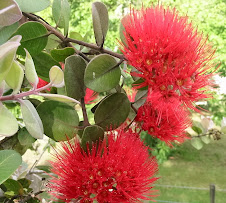 The trees are 25 years old and are planted near our top boundary fence. Most have a good crop of nuts which we had been forgetting to go and pick and DH saw 2 rats running away with nuts, so we thought we better get there and pick our share. You can leave them till they drop but by picking them we know they are fresh and will keep. They hang in bunches and easily come away from the branch. ( next year's tiny nuts are already there too )
The trees are 25 years old and are planted near our top boundary fence. Most have a good crop of nuts which we had been forgetting to go and pick and DH saw 2 rats running away with nuts, so we thought we better get there and pick our share. You can leave them till they drop but by picking them we know they are fresh and will keep. They hang in bunches and easily come away from the branch. ( next year's tiny nuts are already there too )We collected a full sack in less then an hour. Now they are drying in the sun on my trolley and a blanket. As they dry they split exposing the nut. All these outer husks then have to be removed , then further drying before cracking. We have a special cracker but it is still time consuming work - lucky they are so yummy. If you have only ever tasted them coated in chocolate ( YUK ) you have not really tasted them. We lightly roast them to bring out the flavour and add just a hint of salt. They are also good for crumbing and putting in baking. AND they are good for us!
On Christmas afternoon I started a scrap quilt project.( loosely based on my hearts quilt from last April).( I have a system where I save my usable scraps then have a cutting session. I iron the fabric and cut the" best use of," squares or strips from them. These are then put into containers for each different size. That way when I want a quick project some of the cutting is already done.)
I decided to limit the pallet to greens, purples and mauve with some small pattern and lights.The photo shows the stages.
Starting at Left top is a pile of finished squares.
HOW TO.
1. ( TOP MIDDLE )On the base square ( in this case 3.5 inches - could be any size you like ), a free hand circle is then cut from a smaller contrasting fabric.( 2.5 ") and sewn on top. Raw edge. ( start sewing at the top - this gets hidden in the seam later and overlap where you finish sewing )
2.Turn this over and carefully pinch up the fabric and cut a circle away from the back being careful not to cut both. ( like taking the back away from applique )
3.( bottom left )This new salvaged circle is then used as the centre or 2nd circle on another square. This way the fabrics get mixed up for a scrappy look.[ so you have a square base with 2 circles sewn on top]
4.( bottom middle ) The squares are now cut exactly in half.
5. These halves are then mixed and resewn, 1/4 " seam, with a new partner...further mixing up the fabrics.
After that these now rectangular pieces are put in rows to form a quilt top - I haven't got that far get as I don't know how big it is going to be. With washing the raw edges start to fluff like chenille. Using these small sizes I am able to use up lots of 3.5 and 2.5 inch squares.
(Click on to enlarge photos )


























































